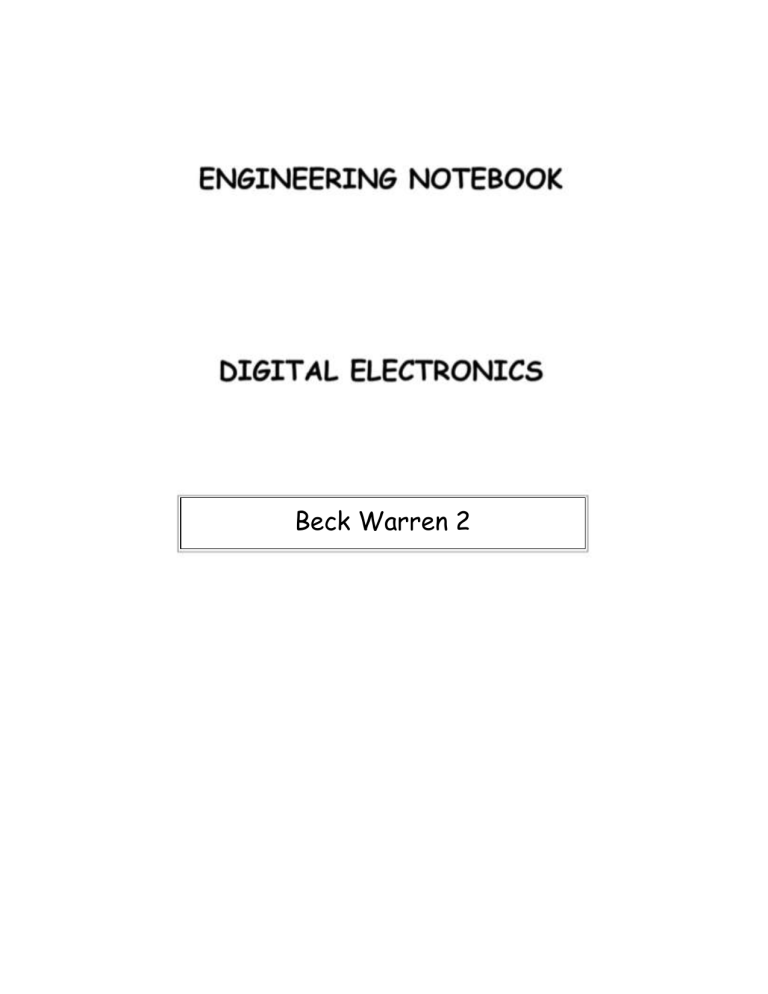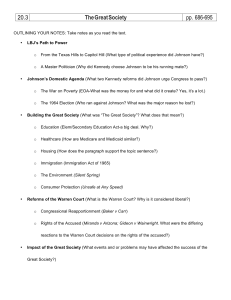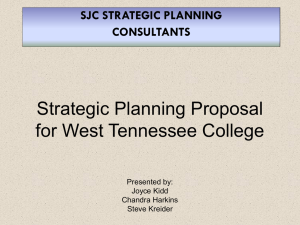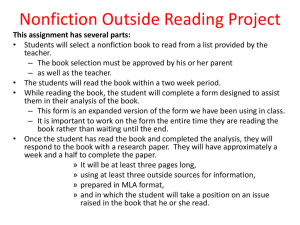
Beck Warren 2 Circuit Theory Laws 1 Component Identification – Digital 7 Circuit Design Process 22 Combinational Logic Design 26 The Binary System 35 Truth Table & Logic Expressions 39 AOI Design Logic Analysis 41 Circuit Simplification: Boolean Algebra 49 1 Circuit Theory Laws Parallel Circuits Characteristics of a Parallel Circuit • The voltage across every parallel component is equal. • The total resistance (RT) is equal to the reciprocal of the sum of the reciprocal: 1 1 1 1 = + + 𝑅𝑇 𝑅1 𝑅2 𝑅3 𝑅𝑇 = 1 1 1 1 + + 𝑅1 𝑅2 𝑅3 The sum of all of the currents in each branch (IR1 + IR2 + IR3) is equal to the total current (IT). This is called Kirchhoff’s Current Law . Beck Warren Bryson Jonson 9-20-22 2 Circuit Theory Laws Example Parallel Circuit 1 1 1 1 = + + 𝑅𝑇 𝑅1 𝑅2 𝑅3 𝑅𝑇 = 𝑅𝑇 = 1 1 1 1 + + 𝑅1 𝑅2 𝑅3 1 𝑅1 𝑥 𝑅2 𝑥 𝑅3 = 𝑅2 𝑅3 + 𝑅1 𝑅3 + 𝑅1 𝑅2 𝑅2 𝑅3 + 𝑅1 𝑅3 + 𝑅1 𝑅2 𝑅1 𝑥 𝑅2 𝑥 𝑅3 Example: For the parallel circuit shown, use the laws of circuit theory to calculate the following: • The total resistance (RT) • The voltage across each component (VT, VR1, VR2, and VR3) Beck Warren Bryson Johnson 9-20-22 3 Circuit Theory Laws • The current flowing through each component (IT, IR1, IR2, and IR3) • Use the results to verify Kirchhoff’s Current Law. Example: Parallel Circuit Solution: Total Resistance: 𝑅𝑇 = 𝑅𝑇 = 1 1 1 1 + + 𝑅1 𝑅2 𝑅3 1 1 1 1 + + 470 2.2𝑘 3.3𝑘 Beck Warren Bryson Johnson 9-20-22 4 Circuit Theory Laws Voltage Across Each Component: Example: Parallel Circuit 𝑉𝑇 = 𝑉𝑅1 = 𝑉𝑅2 = 𝑉𝑅3 = 15 𝑣𝑜𝑙𝑡𝑠 Solution Current through each component 𝐼𝑅1 = 𝐼𝑅1 = 𝑉𝑅1 (𝑂ℎ𝑚′ 𝑠 𝐿𝑎𝑤) 𝑅1 𝑉𝑅1 15𝑣 = = 31.915 𝑚𝐴𝑚𝑝𝑠 𝑅1 470 𝐼𝑅2 = 𝑉𝑅2 15𝑣 = = 6.818𝑚𝐴𝑚𝑝𝑠 𝑅2 2.2𝑘 Beck Warren Bryson Johnson BB 9-20-22 5 Circuit Theory Laws 𝐼𝑅3 = 𝐼𝑇 = 𝑉𝑅3 15𝑣 = = 4.545 𝑚𝐴𝑚𝑝 𝑅3 3.3𝑘 𝑉𝑇 15𝑣 = = 43.278 𝑚𝐴𝑚𝑝 𝑅𝑇 346.59 Solution: Verify Kirchhoff’s Current Law: 𝐼𝑇 = 𝐼𝑅1 + 𝐼𝑅2 + 𝑉𝑅3 43.278 mAmps=31.915mA + 6.818mA + 4.545mA 43.278mAmps= 43.278 mAmps Summary of Kirchhoff’s Laws Kirchhoff’s Voltage Law (KVL): The sum of all of the voltage drops in a series circuit equals the total applied voltage. Kirchhoff’s Current Law (KCL): The total current in a parallel circuit equals the sum of the individual branch currents. Beck Warren Bryson Johnson 9-20-22 6 Circuit Theory Laws Gustav Kirchhoff 1824-1887 German Physicist Beck Warren Bryson Johnson 9-20-22 7 Component Identification - Digital Objectives Introduce transistors, logic gates, integrated circuits (ICs), and explain the relationship of each. • Describe the structure of a truth table and how to “count in binary.” • Present an overview of: • Transistor-Transistor Logic – TTL • Complementary Metal Oxide Semiconductor – CMOS • Define the scale of integration and package styles. • Introduce Manufacturer Datasheets Transistors to Gates • Transistor • An electronic device that is used to control the flow of electricity in electronic equipment. • It has 3 electrodes. • A small voltage controls a larger voltage. • Can act as an amplifier. • Can act as a switch. Beck Warren Bryson Johnson 9-22-22 8 Component Identification - Digital • Gates • Transistors and resistors can be arranged to create desired outputs based on specific inputs (Logic Gates) • Transistors have only two states (on or off) • Binary Number Systems and Boolean Algebra are used to describe the relationship of inputs to outputs on these gates • These input to output relationships can be shown on what are called truth tables Gates to Integrated Circuits (Ics) • Integrated Circuit • An electronic circuit having many components, such as transistors, diodes, resistors, and capacitors in a single package. Beck Warren Bryson Johnson 9-22-22 9 Component Identification - Digital Transistors. Gates and Truth Tables Gates. Integrated Circuits Truth Tables Inputs X and Y might be buttons or switches Output z might be a buzzer or LED For 2 inputs there can only be 4 possible arrangements of the inputs (switches) Truth Tables and Binary Interpreting a Truth Table Truth tables use the binary system (base 2 number system) The ascending rows n this truth table represent a count of (0-3) in the binary number system if you look at inputs x Beck Warren Bryson Johnson 9-22-22 10 Component Identification - Digital And y together. 2 inputs= 4 outputs 3 inputs = 8 outputs 4 inputs = 16 outputs Introduction to Integrated Circuits ICs are categorized in three different ways: The underlying technology upon which their circuitry is based The Scale of Integration Package Style Beck Warren Bryson Johnson 9-22-22 11 Component Identification - Digital Underlying Technology Scale of Integration • Transistor-Transistor Logic – TTL • Complementary Metal Oxide Semiconductor – CMOS • Small Scale Integration – SSI • Medium Scale Integration – MSI • Large Scale Integration – LSI • Very Large Scale Integration – VLSI Package Style • Through-Hole Technology – THT • Dual Inline Packages – DIP • Surface-Mount Technology – SMT • Small Outline IC – SOIC • Plastic Leaded Chip Carrier – PLCC • Quad Flat Pack - QFP Beck Warren Bryson Johnson 9-23-22 12 Component Identification - Digital TTL vs. CMOS • TTL • Bipolar Junction Transistors (BJT) • Faster than CMOS • Not sensitive to damage from electrostatic-discharge • Uses more power than CMOS • CMOS • Metal Oxide Semiconductor Field-Effect Transistors (MOSFET) • Use less power than TTL • Slower than TTL • Sensitive to electrostatic-discharge Beck Warren Bryson Johnson 9-23-22 13 Component Identification - Digital Package Styles Through-Hole Technology (THT) DIP: Dual Inline Package Beck Warren Bryson Johnson 9-23-22 14 Component Identification - Digital Surface Mount Technology (SMT) SOIC: Small QFP: Quad Flat PLCC: Plastic Leaded Chip Through-Hole Technology (THT) • THT components have pins that are inserted into holes drilled in the PCB and soldered on the reverse side of the board. • Advantages: • Designs with THT components are easier to hand-assemble than SMT components, because they are larger. • THT components can be used in protoboards. Beck Warren Bryson Johnson 9-23-22 15 Component Identification - Digital • Disadvantages: • Most high-end electronics components are not available in THT package styles. Through-Hole Technology (THT) DIP: Dual Inline Package Surface Mount Technology (SMT) • SMT components are mounted on the surface of the PCB, so no holes need to be drilled. • Advantages: • Designs with SMT components are smaller than THT. • SMT components have higher pin counts than THT. • SMT components can be mounted on both sides of the Printed Circuit Board. • Disadvantages: • Designs with SMT components are more expensive to manufacture than THT. • SMT components cannot be used in a proto-board. Beck Warren Bryson Johnson 9-23-22 16 Component Identification - Digital TTL Logic Sub-Families Beck Warren Bryson Johnson 9-23-22 17 Component Identification - Digital TTL Logic Gate DM 74 LS 08 N SN 74 LS 08 N Numbering System Package Style(i.e., N=DIP) Logic Function (i.e., 04=Inverter, DM74LS08N or SN74LS08N 08= AND Gate, etc.,) Logic Sub-Family(i.e., Low Power Schottky) 74-Series TTL Manufacturer DM=Fairchild Semiconductor Manufacturer Datasheets SN=Texas Instruments A manufacturers datasheet contains the following information: General Description Connection (pin-out) Diagram Function Table Operating Conditions Beck Warren Bryson Johnson 9-23-22 18 Component Identification - Digital Electrical Characteristics Switching Characteristics Physical Dimensions General Description Beck Warren Bryson Johnson 9-23-22 19 Component Identification - Digital Connection Diagram Function Table Beck Warren Bryson Johnson 20 Component Identification - Digital Recommended Operating Conditions Electrical Characteristcs Beck Warren Bryson Johnson 9-23-22 21 Component Identification - Digital Switching Characteristic s Physical Dimensions Beck Warren Bryson Johnson 9-23-22 22 Circuit Design Process Circuit Design Process objectives Identify and define the requirement specifications: inputs and outputs Identify circuit types required Truth tables Hand calculations Simulation Breadboard and test We will learn about the circuit design process by exploring simple designs in combinational and sequential logic. Beck Warren Bryson Johnson 9-27-22 23 Circuit Design Process Troubleshooti ng Circuits Objectives Define troubleshooting Introduce the types of errors that may require troubleshooting Detail the logical steps required to troubleshoot a nonfunctional digital logic circuit Troubleshooting is the process you must undertake to isolate the source of a problem in a circuit that is not working, and then fix it. Troubleshooting will focus on both combinational and sequential logic. Sources of problems Design error: The circuit works perfectly as designed, but it does not meet the design specification. Build Error: The circuit was built incorrectly or has a bad component. Design & Build Error: The circuit was designed incorrectly and was built wrong. Divide & Conquer Divide the circuit in half Beck Warren Bryson Johnson 9-27-22 24 Circuit Design Process Are the outputs from the first half correct. If no, divide the first half in half again. Keep dividing the faulty half in half until the fault is found Beck Warren Bryson Johnson 9-27-22 25 Circuit Design Process Common Errors Are ICs connected to Vcc and GND? Are you using the correct IC? Are any Ics upside down? Beck Warren Bryson Johnson 9-27-22 26 Combinational Logic Design Objectives Review Logic Symbols And Gate Or Gate Inverter Gate Review Logic Expressions Review Truth Tables Combinational Logic Beck Warren Bryson Johnson 9-20-22 27 Combinational Logic Design Beck Warren Bryson Johnson 9-30-22 28 Combinational Logic Design AOI Logic Combinational logic designs implemented with AND, OR and INVERTER gates are known as AOI designs A O I AOI Example The buzzer is ON whenever the door is OPEN OR when the KEY is in the ignition and the seatbelt is not buckled. Beck Warren Bryson Johnson 10-3-22 29 Combinational Logic Design The buzzer is ON whenever: The DOOR is OPEN OR The KEY is in the IGNITION AND The SEAT BELT is NOT Buckled Beck Warren Bryson Johnson 10-3-22 30 Combinational Logic Design Beck Warren Bryson Johnson 10-3-22 31 Combinational Logic Design Beck Warren Bryson Johnson 10-3-22 32 Combinational Logic Design Beck Warren Bryson Johnson 10-3-22 33 Combinational Logic Design Beck Warren Bryson Johnson 10-3-22 34 Combinational Logic Design Beck Warren Bryson Johnson 10-3-22 35 The Binary System Decimal to binary: problems Divide Decimal by 2. Remainder is the Least Significant Bit (LSB) If quotient is zero, the conversion is complete. If not zero, repeat first step using quotient as the decimal number Example 1: convert decimal 6 into binary Beck Warren Bryson Johnson 10-5-22 36 The Binary System 6 = 3 𝑟 = 0 − 𝐿𝑆𝐵 2 3 =1𝑟 = 1 2 1 = 0 𝑟 = 1 − 𝑀𝑆𝐵 610 = 1102 2 Convert decimal 26 into Binary. 26 = 13 𝑟 = 0 − 𝐿𝑆𝐵 2 13 = 6𝑟 =1 2 6 =3𝑟 = 0 2 3 =1𝑟 = 1 2 1 = 0 𝑟 = 1 − 𝑀𝑆𝐵 2 2610 = 110102 Covert decimal 41 into binary Beck Warren Bryson Johnson 10-5-22 37 The Binary System 41 = 20 𝑟 = 1 − 𝐿𝑆𝐵 2 20 = 10 𝑟 = 0 2 10 = 5𝑟 =0 2 5 2𝑟 =1 2 2 =1𝑟 = 0 2 1 = 0 𝑟 = 1 − 𝑀𝑆𝐵 2 2610 = 110102 1310 = 11012 2210 = 101102 4310 = 1010112 Binary-ToDecimal: Problems 15810 = 100111102 Multiply each bit by the binary number by its corresponding bitweighting factor Sum up all the products in the first step to get the decimal number. Example 1: Convert binary 01102 into its decimal equivalent. Beck Warren Bryson Johnson 10-5-22 38 The Binary System 0 1 1 0 23 22 21 20 8421 0+4+2+1 01102=610 0+4+2+0=610 Convert Binary 100102 into its decimal equivalent. 1 0 0 1 0 24 23 22 21 20 16 8 4 2 1 16+0+0+2+0=1812 100102=1812 Convert binary 01101012 into its decimal equivalent 01102=610 110102=2610 011010125310 110100112=21110 Beck Warren Bryson Johnson 10-5-22 39 Truth Table & Logic Expressions Objectives Properly construct a truth table. Write a sum of products (SOP) logic expression from a truth table. Create a truth table given a SOP logic expression Create a truth table from a set of design specification (i.e. word problem). Beck Warren Bryson Johnson 10-18-22 40 Truth Table & Logic Expressions Beck Warren Bryson Johnson 10-18-22 41 AOI Design Logic Analysis Objectives Determine the circuit output’s truth-table and logic expression Determine the circuits intended function Determine whether a circuit is working properly Circuit Analysis Techniques Circuit to truth table to logic to expression Given a logic circuit… Extract truth table Derive logic expression Circuit to logic expression to truth table Given a logic circuit… Extract logic expression Derive truth table Beck Warren Bryson Johnson 10-19-22 42 AOI Design Logic Analysis Circuit to Truth Table to Add test-points at the gate outputs Logic Design Add a column to the truth table for every test-point Beck Warren Bryson Johnson 10-19-22 43 AOI Design Logic Analysis Complete Column for TP1 Complete column TP2 Complete column for TP3 Beck Warren Bryson Johnson 10-18-22 44 AOI Design Logic Analysis Complete column TP4 Beck Warren Bryson Johnson 10-18-22 45 AOI Design Logic Analysis Complete column TP5 Complete F column Beck Warren Bryson Johnson 10-18-22 46 AOI Design Logic Analysis From the completed truth table, identify the midterms from the truth table anywhere the output is 1. Using the extracted midterms, write the Sum-of-Products logic expressions. 𝐹1 = 𝑋̅𝑌𝑍 + 𝑋𝑌̅𝑍̅ + 𝑋𝑌̅𝑍 Beck Warren Bryson Johnson 10-18-22 47 AOI Design Logic Analysis Working from the inputs to the outputs, write cumulating logic expression at the output of each gate, concluding with the expression for the circuit’s output. Beck Warren Bryson Johnson 10-18-22 48 AOI Design Logic Analysis Circuit to Logic Working from the inputs to the outputs, write cumulating logic expression at the output of each gate, concluding with Expression to Truth Table the the expression for the circuits output Analyze the logic circuit shown below to determine the logic expression for the output F1. Using the logic expression, derive the circuits truth table. Using the circuit’s output logic expression, derive the circuits truth table. Beck Warren Bryson Johnson 10-19-22 49 Circuit Simplification: Boolean Algebra What is Boolean Algebra? Objectives Study a mathematical technique to algebraically simplify logic expressions. Create a logic circuit that is equivalent to the original circuit, yet requires fewer gates. George Boole George Boole My name is George Boole and I lived in England in the 19th century. My work on mathematical logic, algebra, and the binary number system has had a unique influence upon the development of computers. Boolean Algebra is named after me. Beck Warren Bryson Johnson 10-2422 50 Circuit Simplification: Boolean Algebra Boolean Theorems Beck Warren Bryson Johnson 10-2422





